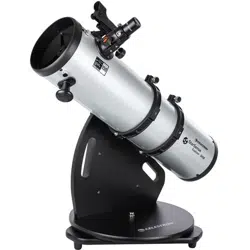Loading ...
Loading ...
Loading ...

14 I ENGLISH
best views from dark skies. Hundreds of galaxies are well
within the observing reach of the SSE Tabletop Dobs.
The best ones display fine details like faint spiral arms
and dust lanes. Many, however, will just appear as non-
stellar “streaks” or “blobs.” Even so, just being able to
detect the light from another galaxy outside our own is
rewarding.
One thing to keep in mind is that the SSE Tabletop Dobs
are not motorized. They will not automatically track celestial
objects as the Earth rotates. As a result, you will notice
that objects drift a bit as you observe them and will exit the
eyepiece’s field of view within a minute or two, depending
on the magnification you are using. Objects will drift out of
the field of higher-power eyepieces faster since their field of
view is narrower. You must manually push the Dob along to
keep objects centered over time. This is easy to do—simply
move it slightly up-and-down and left-to-right as needed.
DARK ADAPTATION AND
LIGHT POLLUTION
It takes at least a half-hour for the human eye to become
dark-adapted, so don’t immediately expect to see subtle
detail in faint deep-sky objects as soon as you get outside.
While observing, avoid any bright lights (like going from
outside to inside a lighted house), or your dark adaption
will need time to reset. Use red flashlights designed for
astronomical use; the red light will not significantly affect
your night vision. The Moon will also affect your dark
adaptation, so if you directly observe the Moon, expect it to
take time to regain your night vision.
Local light pollution will greatly diminish the appearance
and contrast of fainter deep-sky objects in the telescope.
Do not expect to see much detail from urban skies. You’ll
get your best views from dark sky locations away from city
or suburban night lighting. Bright objects such as the Moon,
planets, double stars, and bright open star clusters are not
affected by light pollution as much, so they make suitable
objects for backyard viewing regardless of where you are.
Also, remember that the Moon can light up much of the
night sky, preventing views of faint objects even from dark
sites. So schedule deep-sky observing during or near the
New Moon.
USE OF FILTERS
You can add optional 1.25” format filters to your setup to
help improve the view. Astronomical filters thread onto the
bottom of your eyepiece. Simply remove the eyepiece from
the focuser, thread the filter onto the bottom of its barrel,
and reinsert it into the focuser.
There are many useful filters to choose from:
Moon Filter – An essential for viewing lunar details, this
filter reduces glare and makes bright objects dimmer.
Variable Polarizer – Like a Moon filter, a polarizer dims
your view. The critical difference is that you can customize
the extent of the dimming effect by rotating the polarizer.
Color Filters – Available in various colors, these can
improve contrast when observing planetary details.
Light Pollution Filters – If you view deep-space objects
from urban or suburban skies, these improve contrast
by blocking the “bad” light from local light pollution and
transmitting the “good light” from deep-sky objects. You’ll
notice the greatest improvement in contrast when observing
nebulae.
USING THE OPTIONAL TRIPOD
You can place your SSE Tabletop Dob on a raised platform
to bring the eyepiece to a comfortable height for viewing.
You can use a sturdy table or even the front hood of a car.
You can also place your telescope directly on the ground,
but you’ll likely need to be sitting on the ground yourself—
this can be an excellent way for younger astronomers to use
the SSE Tabletop Dobs.
If you wish to raise the eyepiece height but do not have an
appropriate table or platform, an optional adjustable-height
tripod is available from Celestron. The base of the Tabletop
Dob goes onto the head of the tripod, and the securing
knobs on the tripod head will connect directly to the tripod
adapters at the bottom of the base (Figure 14).
Loading ...
Loading ...
Loading ...
